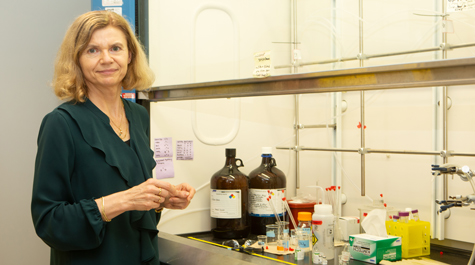Copper-binding peptides — produced by fish — show promise as anticancer agents
Many of the most effective human medicines and therapies have had their origin in nature. Myriam Cotten says there’s a good reason for researchers to look to flora and fauna when seeking new therapies.
“Every organism on earth that has to fight for its life produces compounds similar to the ones that my lab is studying,” Cotten said. “There is a universal theme that organisms produce protective compounds that are co-evolving with the pathogens and the threats they are exposed to.”
Cotten is the Mansfield Associate Professor in William & Mary’s Department of Applied Science. She is the corresponding author on a paper “Copper‑binding anticancer peptides from the piscidin family: an expanded mechanism that encompasses physical and chemical bilayer disruption,” published recently in Nature’s Scientific Reports.
{{youtube:large|KMgJA6W9-U4}}
She has been studying the chemistry of defensive molecules produced by fish. She and her collaborators believe that compounds produced by hybrid striped bass and called piscidins hold promise for a number of clinical applications for humans.
“Water is packed with pathogens,” Cotten explained. “And those pathogens are there 24-7. So, the immune system of the fish is particularly interesting to scientists like me, who want to find natural compounds that can be used to fight antibiotic resistance, cancer and viruses.”
She said a set of compounds known as HDPs, or host defense peptides, show particular promise. Peptides are chains of amino acids. There is an almost unbelievable variety of peptides, and they perform a wide and varied set of jobs in and around the cell.
Cotten has been concentrating her work on a class of HDP peptides known as piscidins. The Scientific Reports paper details a particularly intriguing line of research involving copper-reinforced piscidins as potential anti-cancer agents.
“When I started working on those components, I had no idea that they bound copper,” she said, explaining that she learned about the copper-binding potential of her piscidins from Alfredo Angeles-Boza, who invited her to give a seminar at the University of Connecticut.
“He asked me, ‘Do you know your peptides may be able to bind copper?’” she said. They began working on a set of peptides and identified a couple that readily bind to copper in vitro. The most promising ones were referred to as P1 and P3.
Copper is important for many biological processes, including respiration, host defense, and blood clotting. However, copper is carefully sequestered in vivo to avoid the toxicity of its free state. The biochemical value of numerous copper-binding peptides has been a focus of study, but Cotten’s group is one of a few concentrating on the anti-cancer potential of piscidins.
Cotten and her co-authors (which include Angeles-Boza) found that copper-binding made P1 and P3 especially effective against cancer cells. She explained that HDPs do their defensive work by attacking the membranes of cells and copper-enhanced peptides go to battle armed with a double whammy, attacking the invader cell membranes both chemically and physically.
“The peptides can form a helical structure, much like DNA also exists in a helical form,” Cotten explained. “What happens with the binding is that you modify the structure. Now you have a disrupted helix, with a flatten structure as the head of the peptide and the rest of it actually remains a wrapped helix.”
The disrupted helix shows an improved facility for binding to and disrupting the membranous components of bacteria and cancer cells. Cotten explained that the improvement is two-fold based on studies with model membranes.
“When you bind the copper to the head of the peptide, you actually allow the head to get into the membrane,” she said. “Instead of lying flat on the membrane it now gets deep inside the membrane.”
Penetration is important, she noted, because the membrane is the first line of defense of a cell, guarding the vital enzymes, nucleic acids and other components inside the pathogen.
The second effect is that copper can help form radicals, atomic groupings of oxygen that are characterized by unpaired electrons. Cotten explained that the radicals have a chemical effect, where bonds break in individual molecules present in pathogenic membranes.
“There is a chemical effect where the lipids are broken into pieces,” she said. “The constituents of the membrane are now not only physically pulled apart, but they are also chemically damaged. So now you have a wall where the bricks have been taken out, and you also have bricks that are broken into pieces.”
Cotten notes that scientists have a number of issues to sort out before human therapies based on host defense peptides become a reality. A large set of problems centers on selectivity of HDPs, making sure the peptides attack the targeted pathogen cells and leave the healthy cells alone.
“If you want to bring HDPs into a human setting, you need to modify them in a way they can be delivered exactly where you want them to act,” she said. “For instance, you have to use nanoscience to find a way to surround the peptide with a coating that will bring it to say, cancer cells over healthy cells.”
















